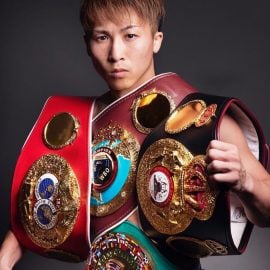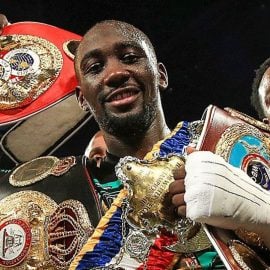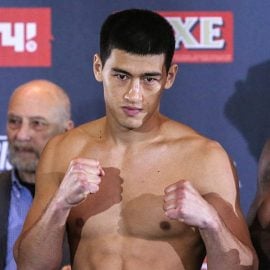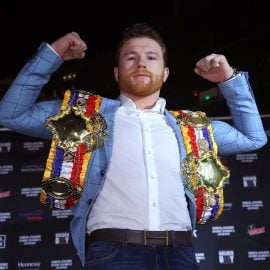Someone’s ‘O’ has got to go: 10 notable fights between unbeaten fighters – Part II

3. Nov. 13, 1992 – Riddick Bowe (31-0) W 12 Evander Holyfield (28-0), Thomas & Mack Center, Las Vegas, Nevada
Boxing is at its highest glory when the world’s two best heavyweights square off in a sold-out arena before a highly-charged, fully engaged crowd. Such was the case when undisputed champion Evander Holyfield defended his belts for the fourth time against mandatory challenger Riddick Bowe, who earned the right to fight “The Real Deal” by knocking out South African Pierre Coetzer in seven rounds a little less than four months earlier. Because they had scored a combined 49 knockouts in their 59 victories, most observers predicted a knockout ending and in a sense they were right. The fight ended up going the distance, but it was a knockout of a fight.
Questions and doubts surrounded both fighters. For Holyfield, it was an issue of size and quality of competition. When he won the 1984 Olympic bronze medal at light heavyweight and won all three cruiserweight title belts as a pro, the sculpted 6-foot-2¾ Holyfield was a physically dominant presence but when he decided to move up to heavyweight many thought he’d be too small to compete in a division populated by super-sized monsters.
Holyfield addressed his critics in the only way he knew how – with action. He stopped the normally durable James “Quick” Tillis in five rounds, then knocked out Pinklon Thomas, Michael Dokes, Adilson Rodrigues, Alex Stewart and Seamus McDonough, most in spectacular fashion. He then achieved his dream of winning the undisputed heavyweight championship with a one-punch knockout of James “Buster” Douglas. These performances erased any questions about Holyfield’s worth as a heavyweight fighter, but, with human nature being what it is, more issues emerged.
 The new criticisms regarded Holyfield’s opposition, and his failure to dominate them as many felt a young, strong and talented heavyweight champion should. He went the full 12 with 42-year-old relics George Foreman and Larry Holmes and received a mighty scare from “Smokin'” Bert Cooper, a late-sub for Mike Tyson, before Holyfield rallied to score a seventh round TKO. At least with Bowe, Holyfield was facing a physically imposing, youthful, hard-hitting and ambitious challenger primed to give him the sternest of acid tests.
The new criticisms regarded Holyfield’s opposition, and his failure to dominate them as many felt a young, strong and talented heavyweight champion should. He went the full 12 with 42-year-old relics George Foreman and Larry Holmes and received a mighty scare from “Smokin'” Bert Cooper, a late-sub for Mike Tyson, before Holyfield rallied to score a seventh round TKO. At least with Bowe, Holyfield was facing a physically imposing, youthful, hard-hitting and ambitious challenger primed to give him the sternest of acid tests.
Like Holyfield, Bowe was an Olympic medalist as he won the super heavyweight silver in Seoul. The 12th of 13 children, Bowe was a native of the Brownsville section of Brooklyn, the same neighborhood that spawned Tyson. But the pair couldn’t have been more different in terms of personality, for while Tyson was introverted Bowe modeled his persona after Muhammad Ali. Quirky and quotable outside the ring, Bowe was capable of mayhem inside it with his 6-foot-5 height and booming blows with both hands.
Many of his imperfections resided between the ears. His focus was centered more on the good life outside the ring instead of the hard work necessary to maximize one’s potential. Manager Rock Newman knew only one man could bring out the very best in Bowe in every possible way.
“There was only one trainer that I thought could and would do the job the way that we wanted it done and that was Eddie Futch,” Newman said. “I had three alternatives – Eddie Futch, Eddie Futch and Eddie Futch.”
“I have worked with five heavyweight champions and Riddick Bowe has the potential to be better than any heavyweight I’ve ever put my hands on,” Futch said, a mighty statement considering he worked with Joe Frazier, Ken Norton and Larry Holmes, among others. But if he was to work with Bowe, the 81-year-old laid down ground rules.
“At the beginning when he started to work with me, he said ‘I don’t have time for games,'” Bowe said. The young fighter agreed to Futch’s terms and over time he developed a bond to the point that the ever-playful Bowe dubbed Futch “Papa Smurf.”
Still, Bowe was a handful-and-a-half and when he reported to training camp to prepare for Holyfield he reported weighing between 270 and 280 pounds. In eight weeks Bowe worked himself down to a fit and ready 235, 10 pounds lighter than was the case before the Coetzer fight.
“When your dream is about to come true, it’s hard not to focus,” Bowe said.
Holyfield’s 205 also raised eyebrows, for it was his lightest weight since the 202 he scaled for his heavyweight debut against Tillis and five pounds less than his defenses against Holmes and Cooper. The champion knew he couldn’t out-big Bowe, so he opted to cut back on the weight training and focus more on speed. But for all the training and preparation Holyfield underwent and the focus he invested, the same couldn’t be said for one member of his team as he forgot to bring “The Real Deal’s” boxing boots to the arena. Luckily, that was the only bad omen on this Friday the 13th, for the boxing world was fated to see a fight for the ages.
Holyfield’s original plan was to box Bowe at long range for the first four rounds and use his skills and superior championship experience (77 rounds to zero) to frustrate the younger and greener challenger. Bowe, for his part, wanted to target Holyfield’s right eye, which took 12 stitches thanks to Larry Holmes’ elbow. He also wanted to engage in a physical war with Holyfield, where his size and strength would be magnified.
Holyfield’s speed and timely punching won the first round. In the final 30 seconds he proved he could rumble on the inside with the bigger man and that he had the chin to absorb his bombs. That knowledge ultimately would prove dangerous to Holyfield, for it emboldened him to the point that he ditched his boxing skills in favor of satisfying his warrior’s instinct.
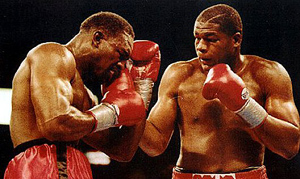 The two engaged in a pulsating trench war in round two that featured fast, powerful and dangerous punches. Neither man ceded an inch, physically or emotionally, and that set the stage for many more such skirmishes. Bowe showed himself to be an extraordinarily effective fighter at short range as vicious uppercuts and hooks sliced through the champion’s defense. By the end of round two, the 19,000-plus in the arena and those watching the live telecast on TVKO knew a classic fight befitting the greatest heavyweight traditions was unfolding before their eyes.
The two engaged in a pulsating trench war in round two that featured fast, powerful and dangerous punches. Neither man ceded an inch, physically or emotionally, and that set the stage for many more such skirmishes. Bowe showed himself to be an extraordinarily effective fighter at short range as vicious uppercuts and hooks sliced through the champion’s defense. By the end of round two, the 19,000-plus in the arena and those watching the live telecast on TVKO knew a classic fight befitting the greatest heavyweight traditions was unfolding before their eyes.
The toe-to-toe trading continued in round three, a round which saw Bowe stun Holyfield with a hook. He answered every Holyfield surge with one of his own and given Bowe’s superior size and punch the math was looking bad for the defending champion. Bowe unveiled a new wrinkle in the fourth with a devoted body attack and his whipping up-and-down combinations stopped Holyfield in his tracks, albeit temporarily. In that round Bowe landed 41 of 77 punches to Holyfield’s 21 of 36.
“Keep the pressure on, he’s tiring,” Futch told Bowe between rounds four and five.
Whenever Bowe struck him with a powerful punch, Holyfield’s indomitable will demanded he pay Bowe back in kind. One such incident took place early in the fifth when Bowe’s powerful right to the chin brought back a thunderous hook from Holyfield, but the bad news for “The Real Deal” was that his best hooks failed to move the challenger. Those blows, however, raised puffiness over Bowe’s right eye but the evidence of Bowe’s effectiveness could be seen by the swelling under Holyfield’s swelling under and over the right orb.
Between rounds six and seven the crowd’s divided passions emerged as one faction chanted “let’s go Bowe” while the Holyfield supporters did their best to drown them out with boos. Bowe tried to make his prediction of a seventh round KO come true when he stunned Holyfield with an enormous right uppercut but the ultra-tough champion survived it and proceeded to rattle in jabs and hooks to the face.
Had Bowe come through with his prediction, the world would have been denied what happened in the 10th, which ranks as among the greatest rounds in heavyweight championship history.
A short right uppercut early in the round caused Holyfield to turn away and totter toward the ropes, where he pounded him with dozens of unanswered punches. As Bowe belabored him with blows from all directions, the champion covered up and glued himself to Bowe’s chest. When Bowe’s artillery spent itself one minute in, Holyfield gathered his forces, then let them go. Two wicked uppercuts, a left hook, an overhand right, another 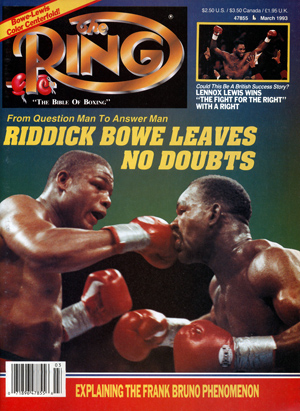 uppercut, a hook and an overhand right stunned Bowe and brought a visceral scream from the throng. It was a remarkable demonstration of Holyfield’s grit and competitive drive and he ended the sensational session with a razor-sharp one-two and a head-swiveling hook that shook the big man to his core.
uppercut, a hook and an overhand right stunned Bowe and brought a visceral scream from the throng. It was a remarkable demonstration of Holyfield’s grit and competitive drive and he ended the sensational session with a razor-sharp one-two and a head-swiveling hook that shook the big man to his core.
As the bell sounded analyst Al Bernstein stated what everyone already knew: “That’s one of the best rounds in heavyweight history! Ever! Period!”
Despite the beating he absorbed late in the 10th, Bowe was able to summon his own resources in the 11th. A short hook turned Holyfield’s body sideways and a right uppercut-left uppercut shook him further. An overhand right above the ear caused Holyfield to turn his back and voluntarily take a knee – the second knockdown of his career. Bowe tore after Holyfield with combinations but the champ survived with a series of clinches and a sudden right lead to the chin that made Bowe grab.
Though exhausted, the sight of the finish line gave them the fuel they needed to get through the 12th. Holyfield landed several pile-driving lefts to the body while Bowe connected with a few one-twos. Given the punishment they dished out in the previous 33 minutes, the somewhat slower pace was excusable, and yet they still exchanged a few blows after the final bell. It was a fitting end to a fabulous fight.
Bowe’s surge in the middle and late rounds enabled him to prevail 117-110 on two scorecards and 115-112 on the third. While the victory established Bowe as a potentially global superstar, Holyfield’s trademark determination rightfully earned him accolades and admiration in defeat.





